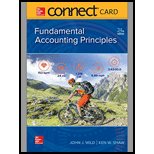
Connect Access Card For Fundamental Accounting Principles
24th Edition
ISBN: 9781260158526
Author: John J Wild
Publisher: McGraw-Hill Education
expand_more
expand_more
format_list_bulleted
Concept explainers
Textbook Question
Chapter 2, Problem 23E
Exercise 2-23 Preparing
Prepare general journal entries for the following transactions of Sustain Company. Use the following (partial) chart of accounts: Cash; Prepaid Insurance;
- June 1 T. lames, owner, invested SI 1,000 cash in Sustain Company.
- The company purchased $4,000 of furniture made from reclaimed wood on credit.
- The company paid $600 cash for a 12-month insurance policy on the reclaimed furniture.
- The company billed a customer $3,000 in fees earned from preparing a sustainability report,
- The company paid $4,000 cash toward the payable from the June 2 furniture purchase.
- The company collected $3,000 cash for fees billed on June 4,
- T. James invested an additional $10,000 cash in Sustain Company.
- The company received $5,000 cash from a client for sustainability services for the next 3 months.
Expert Solution & Answer
Want to see the full answer?
Check out a sample textbook solution
Students have asked these similar questions
General accounting question
Garrison Polymers produces synthetic materials used in the manufacturing of electronic components. In 2015, its first year of operations, Garrison produced 5,000 tons of synthetic material and sold 3,200 tons. In 2016, the company produced the same amount and sales were 6,000 tons (i.e., the company sold all of its inventory). In each year, the selling price per ton was $2,500, variable manufacturing costs per ton were $500, and variable selling expenses were $700 per ton. Fixed manufacturing costs were $5,000,000, and fixed administrative expenses were $600,000. What is the net income under variable costing in year 2015? Help
Don't use ai given answer accounting questions
Chapter 2 Solutions
Connect Access Card For Fundamental Accounting Principles
Ch. 2 - Prob. 1DQCh. 2 - What is the difference between a note payable and...Ch. 2 - Prob. 3DQCh. 2 - What kinds of transactions can be recorded in a...Ch. 2 - Are debits or credits typically listed first in...Ch. 2 - Should a transaction be recorded first in a...Ch. 2 - If assets are valuable resources asset accounts...Ch. 2 - Prob. 8DQCh. 2 - Prob. 9DQCh. 2 - Identify the four financial statements of a...
Ch. 2 - Prob. 11DQCh. 2 - Prob. 12DQCh. 2 - Prob. 13DQCh. 2 - Prob. 14DQCh. 2 - Prob. 15DQCh. 2 - Prob. 16DQCh. 2 - Prob. 17DQCh. 2 - Prob. 18DQCh. 2 - Identifying source documents C1 Identify the items...Ch. 2 - Identifying financial statement accounts C2...Ch. 2 - Reading a chart of accounts C3 A chart of accounts...Ch. 2 - Identifying normal balance C4 Identify the normal...Ch. 2 - QS 2–5
Linking debit or credit with normal...Ch. 2 - Prob. 6QSCh. 2 - Analyzing debit or credit by account A1 Identify...Ch. 2 - Prob. 8QSCh. 2 - Prob. 9QSCh. 2 - Prob. 10QSCh. 2 - Preparing journal entries P1 Prepare general...Ch. 2 - Preparing an income statement P3 Liu Zhang...Ch. 2 - Preparing a statement of owner's equity P3 Use the...Ch. 2 - Prob. 14QSCh. 2 - Prob. 15QSCh. 2 - Exercise 21 Steps in analyzing and recording...Ch. 2 - Prob. 2ECh. 2 - Exercise 2-3 Identifying a ledger and chart of...Ch. 2 - Prob. 4ECh. 2 - Prob. 5ECh. 2 - Prob. 6ECh. 2 - Prob. 7ECh. 2 - Exercise 28 Preparing Taccounts (ledger) and a...Ch. 2 - Prob. 9ECh. 2 - Exercise 2-10 Preparing a trial balance P2 After...Ch. 2 - Prob. 11ECh. 2 - Prob. 12ECh. 2 - Exercise 2-13 Entering transactions into...Ch. 2 - Exercise 2-14 Preparing general journal entries P1...Ch. 2 - Prob. 15ECh. 2 - Prob. 16ECh. 2 - Prob. 17ECh. 2 - Prob. 18ECh. 2 - Prob. 19ECh. 2 - Prob. 20ECh. 2 - Prob. 21ECh. 2 - Exercise 2-22 Calculating and interpreting the...Ch. 2 - Exercise 2-23 Preparing journal entries P1 Prepare...Ch. 2 - Prob. 1APSACh. 2 - Prob. 2APSACh. 2 - Prob. 3APSACh. 2 - Prob. 4APSACh. 2 - Prob. 6APSACh. 2 - Prob. 7APSACh. 2 - Prob. 1BPSBCh. 2 - Prob. 2BPSBCh. 2 - Prob. 3BPSBCh. 2 - Prob. 4BPSBCh. 2 - Problem 2-5B Computing net income from equity...Ch. 2 - Prob. 6BPSBCh. 2 - Problem 2-7B Preparing an income statement,...Ch. 2 - SP 2 On October 1, 2019, Santana Rey launched a...Ch. 2 - Using transactions from the following assignments...Ch. 2 - Prob. 2GLPCh. 2 - Prob. 3GLPCh. 2 - Prob. 4GLPCh. 2 - Prob. 5GLPCh. 2 - Prob. 6GLPCh. 2 - Prob. 7GLPCh. 2 - Prob. 8GLPCh. 2 - Refer to Apple's financial statements in Appendix...Ch. 2 - Prob. 2AACh. 2 - Key comparative figures for Apple, Google, and...Ch. 2 - Prob. 1BTNCh. 2 - Prob. 2BTNCh. 2 - Prob. 3BTNCh. 2 - Prob. 4BTNCh. 2 - Prob. 5BTNCh. 2 - Prob. 6BTNCh. 2 - Prob. 7BTN
Knowledge Booster
Learn more about
Need a deep-dive on the concept behind this application? Look no further. Learn more about this topic, accounting and related others by exploring similar questions and additional content below.Similar questions
arrow_back_ios
SEE MORE QUESTIONS
arrow_forward_ios
Recommended textbooks for you
- Century 21 Accounting Multicolumn JournalAccountingISBN:9781337679503Author:GilbertsonPublisher:Cengage
 Cornerstones of Financial AccountingAccountingISBN:9781337690881Author:Jay Rich, Jeff JonesPublisher:Cengage Learning
Cornerstones of Financial AccountingAccountingISBN:9781337690881Author:Jay Rich, Jeff JonesPublisher:Cengage Learning - Principles of Accounting Volume 1AccountingISBN:9781947172685Author:OpenStaxPublisher:OpenStax College
 College Accounting, Chapters 1-27AccountingISBN:9781337794756Author:HEINTZ, James A.Publisher:Cengage Learning,
College Accounting, Chapters 1-27AccountingISBN:9781337794756Author:HEINTZ, James A.Publisher:Cengage Learning, Financial And Managerial AccountingAccountingISBN:9781337902663Author:WARREN, Carl S.Publisher:Cengage Learning,
Financial And Managerial AccountingAccountingISBN:9781337902663Author:WARREN, Carl S.Publisher:Cengage Learning,


Century 21 Accounting Multicolumn Journal
Accounting
ISBN:9781337679503
Author:Gilbertson
Publisher:Cengage

Cornerstones of Financial Accounting
Accounting
ISBN:9781337690881
Author:Jay Rich, Jeff Jones
Publisher:Cengage Learning

Principles of Accounting Volume 1
Accounting
ISBN:9781947172685
Author:OpenStax
Publisher:OpenStax College

College Accounting, Chapters 1-27
Accounting
ISBN:9781337794756
Author:HEINTZ, James A.
Publisher:Cengage Learning,

Financial And Managerial Accounting
Accounting
ISBN:9781337902663
Author:WARREN, Carl S.
Publisher:Cengage Learning,
The ACCOUNTING EQUATION For BEGINNERS; Author: Accounting Stuff;https://www.youtube.com/watch?v=56xscQ4viWE;License: Standard Youtube License